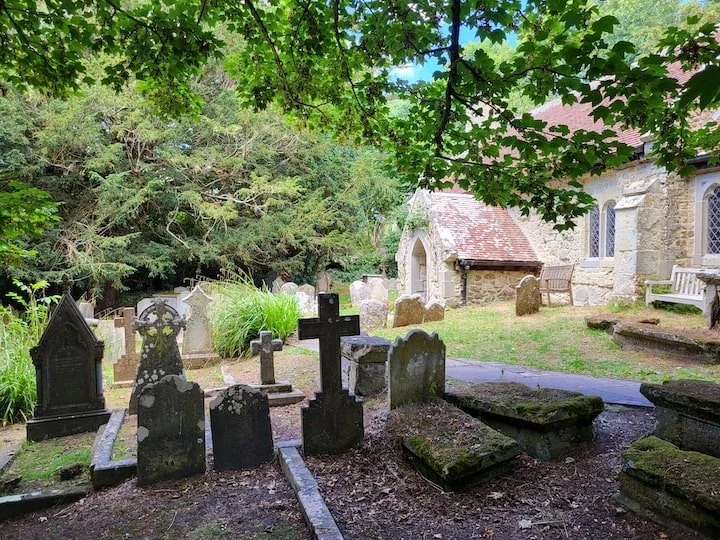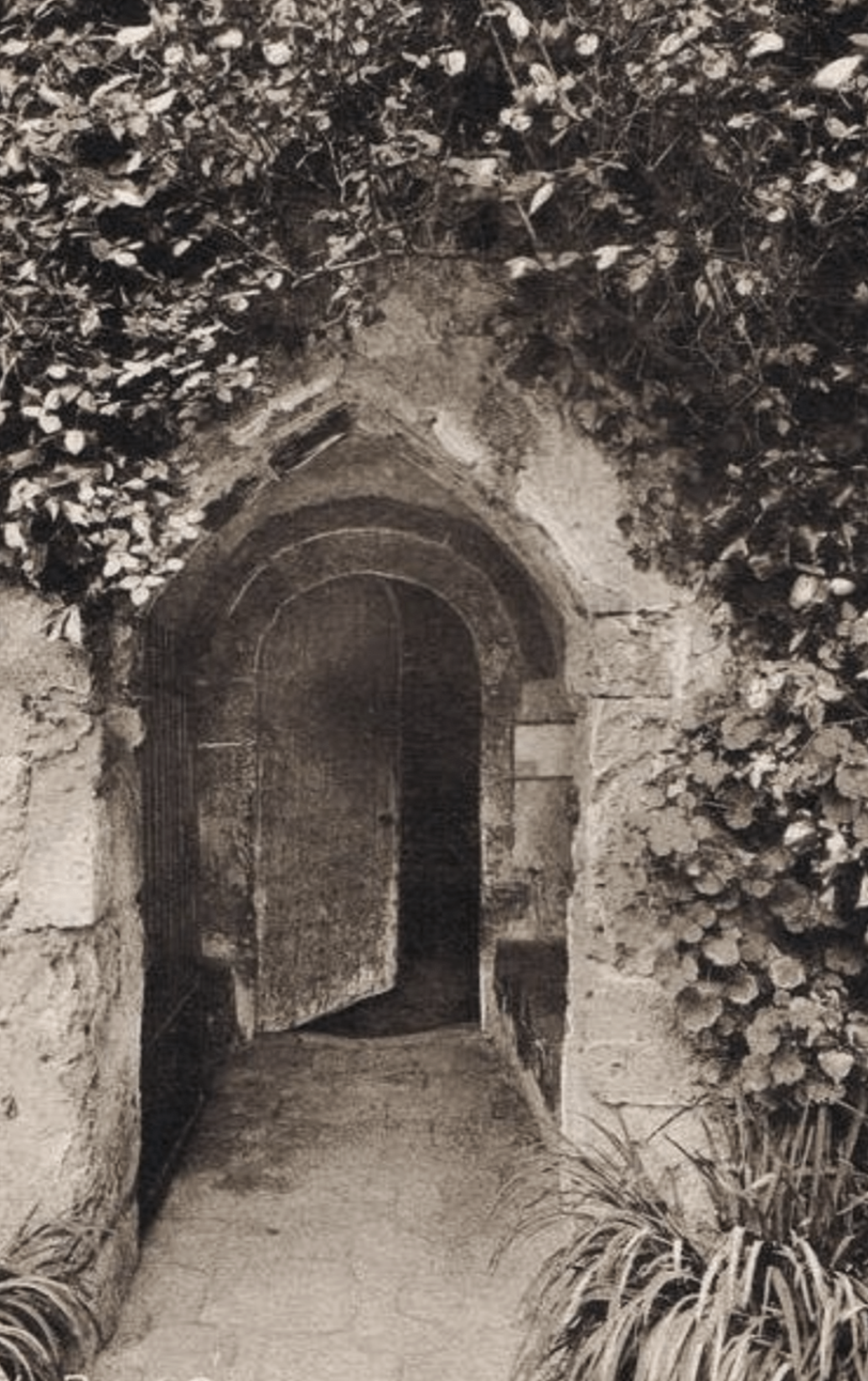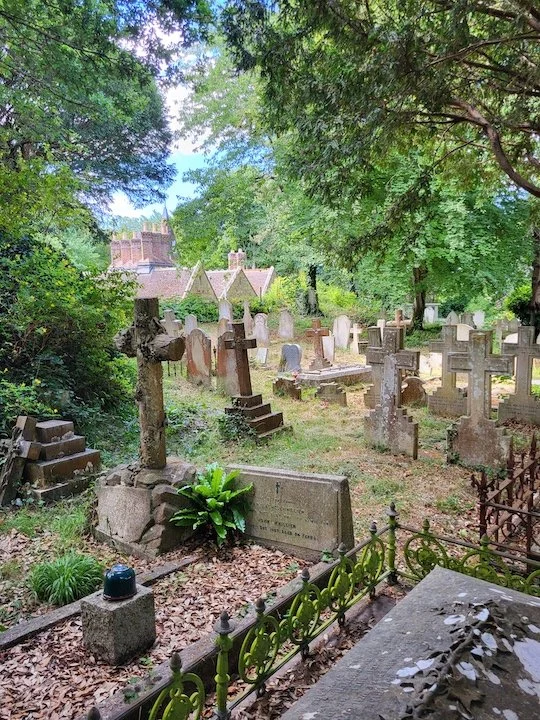Launch of a new Walk, The Souls of Bonchurch
Walking with Souls: Launching the Souls of Bonchurch Walk
On Monday, 16th June, I had the great pleasure of launching the
Souls of Bonchurch Walk—a journey made even more memorable by perfect walking weather: warm, calm, and just overcast enough to keep things comfortable. It was the ideal day for a gentle meander through Bonchurch’s two extraordinary graveyards, each rich with history and layered stories.
Our first stop was the ancient church and graveyard at the base of Bonchurch Shute. To reach the Old Church, the old road veers toward the poet Algernon Swinburne’s family home of East Dene and ends in a peaceful cul-de-sac by the church.
The Old Church St.Boniface, Bonchurch. Rebuilt 1070
The History of Bonchurch’s 11th-century Church and Churchyard
We began near the old pay booth at the old church, where we learned that visitors in the 1960s once paid sixpence to explore the site. That charming detail immediately set a tone of time travel. Armed with old maps of the village, we traced Bonchurch’s past through its shifting geography and architecture, beginning to see the landscape not just as it is, but as it once was.
Tucked away just beyond the pay booth is the
11th-century Old Church—a quiet, weathered sanctuary surrounded by tombs dating back to the 1600s. One particularly evocative tale we uncovered was of a burial connected to a skirmish with the French around the time the Mary Rose sank in the Solent near Portsmouth.
Before the church was built
Nearby flows The Source, a freshwater spring that has never run dry—even during the droughts of the 1970s. This sacred spring is said to mark the very beginning of Bonchurch’s story, and standing beside it, you can feel its quiet, enduring presence. Numerous illustrations were shared with the walkers, enriching the narrative, lending vivid detail to the histories of the churchyard and its fascinating inhabitants who are buried there.
The New Church, St. Boniface Parish Church. Consecrated in 1848.
From there, we made the short but steep climb up Bonchurch Shute to the second, much larger Victorian St. Boniface Parish Church stands here, nestled within a picturesque, tranquil churchyard dotted with memorial stones — each offering a glimpse into the lives of those who shaped Bonchurch’s more recent past.
Famous visitors to Swinburne’s grave
Numerous famous people visited Algernon Swinburne’s grave. Each brings a different emotion.
His friend William Rosetti’s daughter was furious during the burial service. Thomas Hardy visited later, as he was suffering from rheumatism. He wrote his poem ‘A Singer Asleep’, dedicated to Swinburne.
According to an account by her brother Osbert, Edith Sitwell made a striking visit to Swinburne’s grave: she arrived by boat, defied the sexton, and ritually laid down milk, bay leaves, honeycomb, and roses.
The tradition of laying roses continues today.
A SINGER ASLEEP
I
In this fair niche above the unslumbering sea,
That sentrys up and down all night, all day,
From cove to promontory, from ness to bay,
The Fates have fitly bidden that he should be Pillowed eternally.
II
- It was as though a garland of red roses
Had fallen about the hood of some smug nun
When irresponsibly dropped as from the sun,
In fulth of numbers freaked with musical closes,
Upon Victoria's formal middle time
His leaves of rhythm and rhyme.
III
O that far morning of a summer day
When, down a terraced street whose pavements lay
Glassing the sunshine into my bent eyes,
I walked and read with a quick glad surprise
New words, in classic guise, -
IV
The passionate pages of his earlier years,
Fraught with hot sighs, sad laughters, kisses, tears;
Fresh-fluted notes, yet from a minstrel who
Blew them not naively, but as one who knew
Full well why thus he blew.
V
I still can hear the brabble and the roar
At those thy tunes, O still one, now passed through
That fitful fire of tongues then entered new!
Their power is spent like spindrift on this shore;
Thine swells yet more and more.
VI
- His singing-mistress verily was no other
Than she the Lesbian, she the music-mother
Of all the tribe that feel in melodies;
Who leapt, love-anguished, from the Leucadian steep
Into the rambling world-encircling deep
Which hides her where none sees.
VII
And one can hold in thought that nightly here
His phantom may draw down to the water's brim,
And hers come up to meet it, as a dim
Lone shine upon the heaving hydrosphere,
And mariners wonder as they traverse near,
Unknowing of her and him.
VIII
One dreams him sighing to her spectral form:
"O teacher, where lies hid thy burning line;
Where are those songs, O poetess divine
Whose very arts are love incarnadine?"
And her smile back: "Disciple true and warm,
Sufficient now are thine." . . .
IX
So here, beneath the waking constellations,
Where the waves peal their everlasting strains,
And their dull subterrene reverberations
Shake him when storms make mountains of their plains -
Him once their peer in sad improvisations,
And deft as wind to cleave their frothy manes -
I leave him, while the daylight gleam declines
Upon the capes and chines.
THOMAS HARDY
BONCHURCH, 1910.
Written when visiting with Florence Dugdale
The Egyptian-style tomb was built for Dr. Leeson’s son.
Across the two churchyards, we paused at several key graves and uncovered remarkable stories. We met a renowned brewer, a master lighthouse builder, the very builders of Bonchurch itself, the infamous Pre-Raphaelite poet Algernon Swinburne, and even a king. The great historian Thomas Carlyle also had connections to this place.
A reminder of how Bonchurch has quietly drawn extraordinary individuals into its fold.
Here’s what some of the guests had to say:
“An intriguing insight into the stories of some of the people of Bonchurch—not to be missed.”
Regular island visitor Glenda Shepherd wrote, ‘The walk was very informative and interesting; however, the old church wasn’t very well signposted from the top of Bonchurch Shute’.
“It was absolutely wonderful. I had no idea,” remarked a longtime resident of Bonchurch.
With thanks to the Isle of Wight Archives, Newport. Image of Swinburne’s grave.










